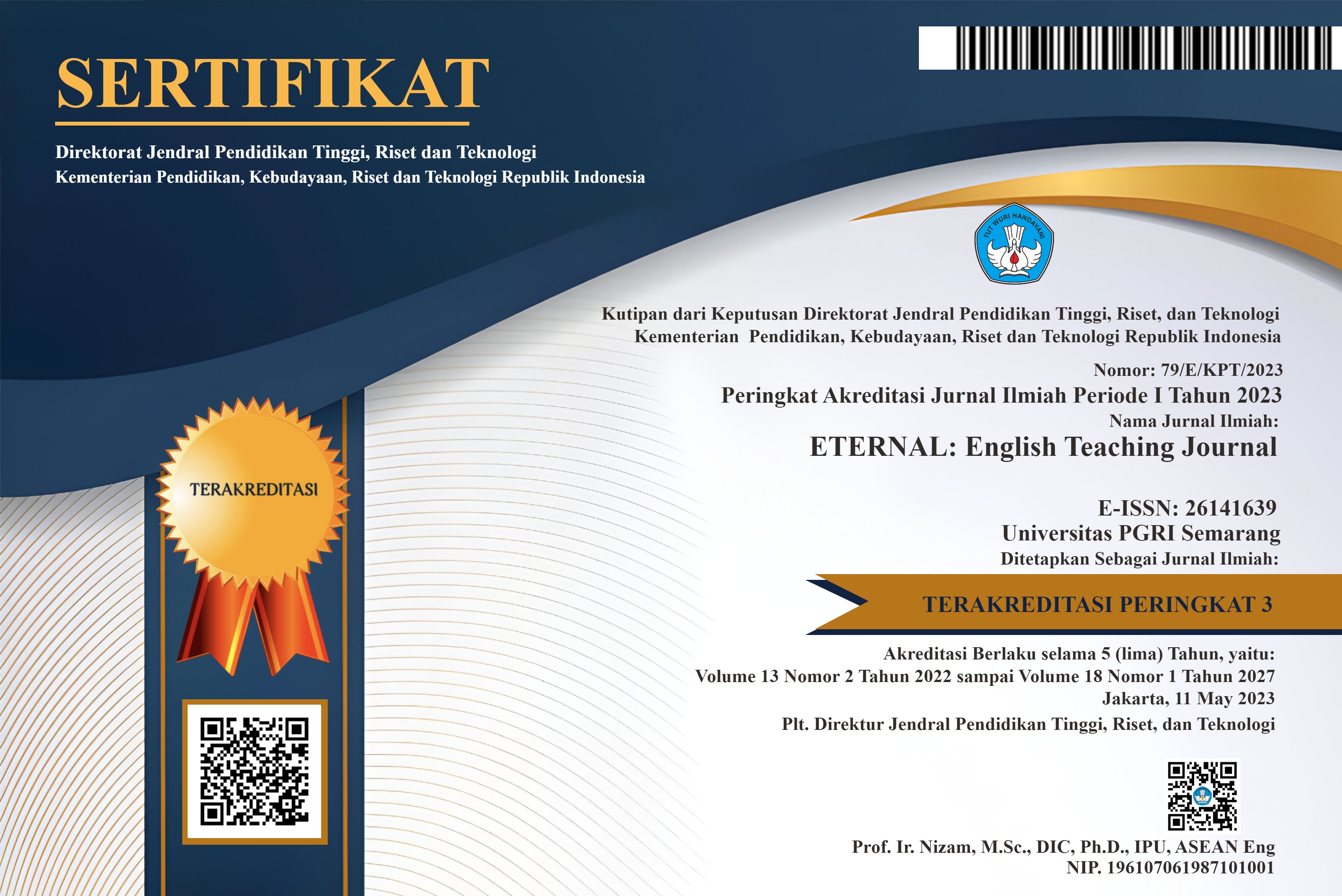Critical Digital Pedagogy’s Framework: Lecturer’s Voices to Analysis the Incorporation of Discord Tool in Higher Education
DOI:
https://doi.org/10.26877/eternal.v15i1.353Keywords:
Critical Digital Pedagogy, lecturer’s voices, DiscordAbstract
Critical pedagogy can be reflected in the situation when the learners become social transformers of their community and world, and when they critically construct knowledge. The prior researchers s only evaluated discrepancies in gender and age. Freire and Brown's framework also verified the feasibility and reliability of implementing CDP. However, general skills and unspecific digital tools drove the reader's bias and ambiguity. Consequently, the purposes of the study aim to connect previous topics in different contexts, addressing the gap and providing a critical analysis. Especially, English lectures in certain skills and specific digital tools would be needed to know critical pedagogy's intentional implementation or unintentional presence in the ELT realm. Three concerns were highlighted to guide the researchers to do the research; the essential aspect of pedagogy that has and has not been involved yet in online learning and the factors of age and gender that might influence the learning. Th researchers s used qualitative method, especially observation and questionnaire instruments to get the data of the incorporation of the Discord tool of critical pedagogy in the higher education domain. The findings reveals that the implementation a critical pedagogy of Discord tool and the discrepancies of age and gender that influence the online meeting.
References
Ahuja, M. K., & Thatcher, J. B. (2005). Moving beyond intentions and toward the theory of trying: Effects of work environment and gender on post-adoption information technology use. MIS Quarterly, 29(3), 427–459
Akdeniz, H., & Bangir Alpan, G. (2020). Analysis of gifted and talented students' creative problem-solving styles. Talent, 10(1), 79-94. DOI: https://doi.org/10.46893/talent. 758416.
Allen, M. (2017). The SAGE Encyclopedia of Communication Research Methods. SAGE Publications.
Anis, M., & Anwar, C. (2020). Self-organized learning environment teaching strategy for ELT in Merdeka Belajar concept for high school students in Indonesia. JEES (Journal of English Educators Society), 5(2), 199-204.
Bundick, M. J., Quaglia, R. J., Corso, M. J., & Haywood, D. E. (2014). Promoting student engagement in the classroom. Teachers College Record, 116(4).
Brown, H. D. (2001). Teaching by principles. Longman.
Cramer, D., & Howitt, D. (2004). The SAGE Dictionary of Statistics: A Practical Resource for Students in the Social Sciences. SAGE.
Dreamson, N. (2019). Critical understandings of digital Technology in Education. https://doi.org/10.4324/9780429277528
Freire, P. (1959). Educação e atualidade brasileira. http://acervo.paulofreire.org:8080/xmlui/handle/7891/1976
Freire, P. (1967 [1974]). Education: the practice of freedom. Originally published in 1967 as Educaçåo ecomo práctica de liberdade. Rio de Janeiro: Paz e Terra. Published in English in 1974 as part of Education for critical consciousness. Sheed & Ward.
Freire, P. (1996). Pedagogia da Autonomia: saberes necessários à prática educativa. (28th ed). São Paulo, Brazil: Paz e Terra.
Freire, P. (2004). Pedagogy of indignation. Paradigm Publishers. Freire, P. (2014). Pedagogy of commitment (D. Brookshaw & A. Oliveira, Trans.). Paradigm Publishers.
Jeyaraj, J. J., & Harland, T. (2016). Teaching with critical pedagogy in ELT: the problems of indoctrination and risk. Pedagogy, Culture and Society, 24(4), 587–598. https://doi.org/10.1080/14681366.2016.1196722
Lima, L., & Gouveia, P (2020). Gender Asymmetries in the Digital Games Sector in Portugal. In Proceedings of DiGRA 2020.
Lunevich, L. (2021b). Critical Digital Pedagogy and Innovative Model, Revisiting Plato and Kant: An Environmental Approach to Teaching in the Digital Era. Creative Educa-tion, 12, 2011-2024. . https://doi.org/10.4236/ce.2021.129154
McLaren, P. (2007). Life in schools: An introduction to critical pedagogy in the foundation of education. New York, NY: Pearson/Allyn & Bacon.
Stommel, J., & Morris, S. M. (2018). An Urgency of Teachers: The Work of Critical Digital Pedagogy.
Stommel, J., Friend, C., & Morris, S. M. (2020). Critical Digital Pedagogy: A Collection.
Swales, J. M., & Feak, C. B. (2004b). Academic Writing for Graduate Students: Essential Tasks and Skills. University of Michigan Press ELT.feak
Riasati, M., & Mollaei, F. (2012). Critical pedagogy and language learning. International Journal of Humanities and Social Science, 2(21), 223-229.
Traxler, J. A. (2021). Critical Mobile Pedagogy, Cases of Digital Technologies and Learn-ers at the Margins. Routledge. https://doi.org/10.4324/9780429261572
Tricia, K. (2021). Critical Pedagogy for Healing: Paths beyond Wellness, toward a Soul Revival Teaching and Learning. Bloomsbury Publishing Plc
Mouna Denden;Ahmed Tlili;Fathi Essalmi;Mohamed Jemni;Nian-Shing Chen;Daniel Burgos; (2021). Effects of gender and personality differences on students’ perception of game design elements in educational gamification . International Journal of Human-Computer Studies, (), –. doi:10.1016/j.ijhcs.2021.102674
Park, C., Kim, D. G., Cho, S., & Han, H. J. (2019). Adoption of multimedia technology for learning and gender difference. Computers in Human Behavior, 92, 288-296
Redman, P., & Maples, W. (2017). Good Essay Writing: A Social Sciences Guide. SAGE Publications Limited.
Setyarini, S., Muslim, A. B., Rukmini, D., Yuliasri, I., & Mujianto, Y. (2018). Thinking critically while storytelling: Improving children’s HOTS and English oral competence. Indonesian Journal of Applied Linguistics, 8(1), 189-197.
Subkhan, E. (2020). What is new on curriculum policy and how it affects curriculum studies? Indonesian Journal of Curriculum and Educational Technology Studies, 8(1), 56-61.
Swales, J. M., & Feak, C. B. (2004b). Academic Writing for Graduate Students: Essential Tasks and Skills. University of Michigan Press ELT.
Yulianto, S. W. (2015). The use of critical pedagogy principles in teaching EFL Reading. English Review 4(1), 25-38
Yıldız, P., Gürel, R., Bozkurt, E., & Yetkin-Özdemir, E. (2022). Self-regulation of novice middle school mathematics teachers in the preparation process for teaching. International Online Journal of Education and Teaching (IOJET), 9(1). 449-470. https://iojet.org/index.php/IOJET/article/download/1520/768
Waddell, M. and Clariza, E. (2018), “Critical digital pedagogy and cultural sensitivity in the library classroom: infographics and digital storytelling”, College and Research Libraries News, Vol. 79 No. 5, p. 228, available at: https://crln.acrl.org/index.php/crlnews/article/view/16963







